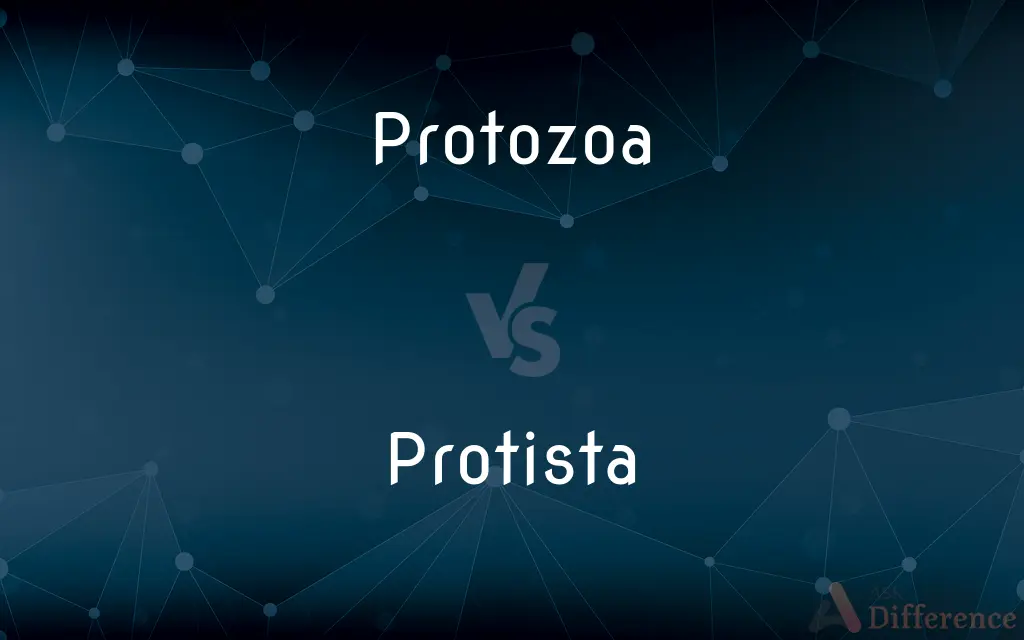Protozoa vs. Protista — What's the Difference?
By Fiza Rafique & Urooj Arif — Updated on April 26, 2024
Protozoa are a diverse group of single-celled eukaryotic organisms, often predatory, while Protista is a broader kingdom including protozoa, algae, and slime molds.

Difference Between Protozoa and Protista
Table of Contents
ADVERTISEMENT
Key Differences
Protozoa are primarily characterized as single-celled, motile organisms that are often heterotrophic, feeding on organic matter. In contrast, Protista includes a wider variety of organisms, from single-celled protozoans to multicellular algae and slime molds, encompassing both heterotrophic and autotrophic life forms.
While protozoa typically thrive in moist or aquatic environments and play key roles as predators or parasites, Protista as a group can be found in an array of habitats, including freshwater, marine environments, and damp terrestrial locations. This variety reflects their diverse modes of nutrition and ecological roles.
Protozoa reproduce mostly asexually through processes like binary fission or budding, though some exhibit forms of sexual reproduction. Protista, however, displays a wider array of reproductive strategies, from simple asexual reproduction in algae to complex sexual cycles seen in some protozoa and multicellular forms.
In terms of classification, protozoa were once considered a subcategory within the Protista, but recent advances in molecular biology and genetics have led to a reevaluation of their relationships, leading to more complex and accurate phylogenetic trees. Protista itself is often treated as a paraphyletic group, meaning it consists of a common ancestor and some, but not all, of its descendants.
The study of protozoa focuses on aspects like disease causation in humans and other animals, water quality assessment, and ecological balance. Meanwhile, studying Protista encompasses these areas while also delving into broader subjects like algal biofuels, climate change effects on marine ecosystems, and evolutionary biology.
ADVERTISEMENT
Comparison Chart
Cellular Structure
Mostly unicellular
Unicellular and multicellular
Habitat
Primarily moist and aquatic
Varied, including aquatic and damp terrestrial
Nutrition
Mostly heterotrophic
Heterotrophic and autotrophic
Reproduction
Mainly asexual, some sexual
Asexual and sexual, diverse forms
Role in Ecology
Predators, parasites
Predators, producers, decomposers
Compare with Definitions
Protozoa
A diverse group of single-celled eukaryotes, usually motile.
Amoebas, a type of protozoa, move using pseudopods.
Protista
A kingdom of diverse organisms, including protozoa, algae, and slime molds.
Kelp, a large seaweed, is part of the Protista kingdom.
Protozoa
Often serve as predators or parasites in their ecosystems.
Malaria is caused by Plasmodium, a parasitic protozoan.
Protista
Includes organisms with different types of nutrition.
Algae are autotrophic, producing energy through photosynthesis.
Protozoa
Capable of both sexual and asexual reproduction.
The protozoan Giardia reproduces by binary fission.
Protista
Can be either single-celled or multicellular.
Diatoms are single-celled algae within the Protista.
Protozoa
Play a significant role in nutrient cycling and water quality.
Protozoa in aquatic habitats consume bacteria, regulating microbial populations.
Protista
Exhibits a variety of reproductive strategies.
Some algae reproduce sexually, forming spores that can withstand harsh conditions.
Protozoa
Studied for their impacts on human health and environmental stability.
Research on protozoa focuses on their roles in diseases like sleeping sickness.
Protista
Important in research for environmental and biological studies.
Protista studies help scientists understand evolutionary processes and ecological dynamics.
Protozoa
Protozoa (also protozoan, plural protozoans) is an informal term for a group of single-celled eukaryotes, either free-living or parasitic, that feed on organic matter such as other microorganisms or organic tissues and debris. Historically, protozoans were regarded as "one-celled animals", because they often possess animal-like behaviours, such as motility and predation, and lack a cell wall, as found in plants and many algae.
Protista
Plural of protiston
Protozoa
Any of numerous chiefly single-celled eukaryotic organisms, most of which move about freely and ingest food, including the amoebas, ciliates, flagellates, and apicomplexans. Protozoans along with certain algae, oomycetes, and some other groups make up the protists.
Protista
A provisional group in which are placed a number of low microscopic organisms of doubtful nature. Some are probably plants, others animals.
Protozoa
Plural of protozoan
Protista
Eukaryotic one-celled living organisms distinct from multicellular plants and animals: protozoa, slime molds, and eukaryotic algae
Protozoa
Plural of protozoon
Protozoa
The lowest of the grand divisions of the animal kingdom.
Protozoa
In some classifications considered a superphylum or a subkingdom; comprises flagellates; ciliates; sporozoans; amoebas; foraminifers
Common Curiosities
Are Protozoa harmful to humans?
Some protozoa cause diseases such as malaria and amoebiasis, but many are harmless and play crucial ecological roles.
Can Protista be multicellular?
Yes, Protista includes multicellular organisms like algae, which can range from microscopic diatoms to large seaweeds.
What role do Protozoa play in ecosystems?
Protozoa are critical in nutrient cycling and as part of the food web, serving as both predators and prey in aquatic and soil ecosystems.
What types of environments do Protista inhabit?
Protista are extremely versatile, inhabiting a wide range of environments from freshwater and marine ecosystems to damp terrestrial locations like soil and moss.
Can Protista be used in biotechnology or industry?
Yes, certain algae (a group within Protista) are used in the production of biofuels, bioplastics, and as a source of nutritional supplements.
How do scientists classify Protista?
Protista is often considered a paraphyletic group, classified based on a mixture of genetic, morphological, and ecological characteristics, which has been evolving with advances in molecular biology.
What are some common diseases caused by Protozoa?
Common diseases include malaria (caused by Plasmodium), giardiasis (caused by Giardia lamblia), and sleeping sickness (caused by Trypanosoma).
What distinguishes Protozoa from other Protista?
Protozoa are predominantly heterotrophic and motile, focusing on predatory or parasitic lifestyles, unlike some Protista which include photosynthetic algae.
How do Protista contribute to environmental health?
Protista, like algae, contribute significantly to oxygen production and carbon cycling, particularly in aquatic environments.
Why are Protozoa important in biological research?
They are studied for their roles in disease, ecological interactions, and as models for cellular processes.
How do changes in climate or environment affect Protista?
Changes like temperature shifts, pollution, and acidification can impact Protista, particularly algae, affecting their reproduction, photosynthesis rates, and survival.
How do Protista reproduce?
Reproduction in Protista can be complex, involving both asexual methods like binary fission and sexual reproduction through gametes, depending on the species.
How are Protozoa observed for scientific study?
Protozoa are often observed using microscopes due to their small size, with samples typically collected from water or soil.
What are the ecological impacts of Protozoa in water bodies?
In water bodies, Protozoa help regulate bacterial populations and break down organic material, thus maintaining water quality and ecosystem health.
What is the importance of studying Protista in climate change research?
Studying Protista, especially algae, is crucial for understanding carbon sequestration and oxygen production in global ecosystems, key factors in climate regulation.
Share Your Discovery

Previous Comparison
Lattice vs. Crystal
Next Comparison
Risk vs. VulnerabilityAuthor Spotlight
Written by
Fiza RafiqueFiza Rafique is a skilled content writer at AskDifference.com, where she meticulously refines and enhances written pieces. Drawing from her vast editorial expertise, Fiza ensures clarity, accuracy, and precision in every article. Passionate about language, she continually seeks to elevate the quality of content for readers worldwide.
Co-written by
Urooj ArifUrooj is a skilled content writer at Ask Difference, known for her exceptional ability to simplify complex topics into engaging and informative content. With a passion for research and a flair for clear, concise writing, she consistently delivers articles that resonate with our diverse audience.














































